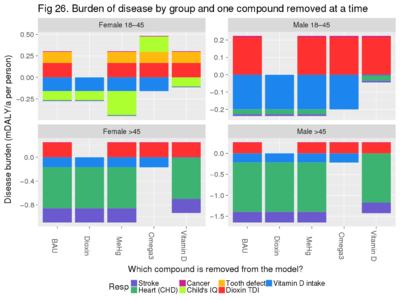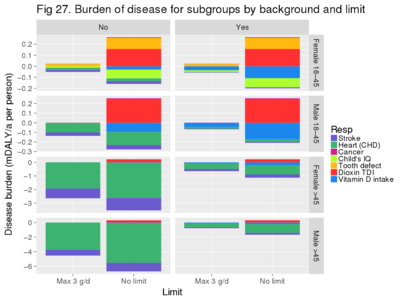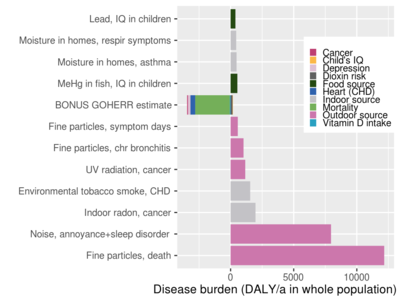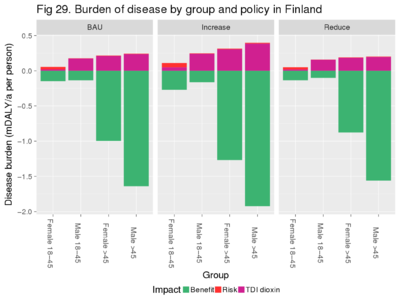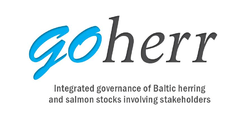Benefit-risk assessment of Baltic herring and salmon intake
In Opasnet many pages being worked on and are in different classes of progression. Thus the information on those pages should be regarded with consideration. The progression class of this page has been assessed:
|
The content and quality of this page is/was being curated by the project that produced the page.
The quality was last checked: 2018-05-21. |
| Main message: |
|---|
| Question:
What are the current individual and population level health benefits and risks of eating Baltic herring and salmon in Finland, Estonia, Denmark and Sweden? How would the health effects change in the future, if consumption of Baltic herring and salmon changes due to actions caused by a) fish consumption recommendations or limitations, b) different management scenarios of Baltic sea fish stocks, or c) selection of fish sizes for human consumption? BONUS GOHERR project (2015-2018) looked at this particular question. A health impact assessment was performed based on fish consumption survey done in the four target countries; EU Fish 2 study about dioxin and PCB concentrations; a dynamic growth model about Baltic herring stock sizes and dioxin accumulation; scientific literature about exposure-response functions of several compounds found in Baltic fish; and online models produced in Opasnet web-workspace. Dioxin and PCB concentrations have been constantly decreasing in Baltic fish for 40 years, and now they are mostly below EU limits. Also Baltic herring consumption has been decreasing during the last decades and is now a few grams per day, varying between age groups (old people eat more), genders (males eat more) and countries (Estonians eat more and Danes less than others). People reported that better availability of easy products, recipes, and reduced pollutant levels would increase their Baltic herring consumption. In contrast, recommendations to reduce consumption would have little effect on average. Health benefits of Baltic herring and salmon clearly outweigh health risks in age groups over 45 years. Benefits are higher even in the most sensitive subgroup, women at childbearing age. The balance is close to even, if exceedance of the tolerable daily intake is given weight in the consideration and if other omega-3 sources are given priority over fish. The analysis was robust in a sense that we did not find uncertainties that could remarkably change the conclusions and suggest postponing decisions in hope of new information. Overall, main arguments from this health assessment and other disciplines studied in Goherr are in favour of getting rid of dioxin-based food restrictions related to Baltic herring and salmon, and promoting human consumption of Baltic fish. |

![]() Assessment presentation ·
show ready-made model results
Assessment presentation ·
show ready-made model results
Scope
This assessment is part of the WP5 work in Goherr project. Purpose is to evaluate health benefits and risks caused of eating Baltic herring and salmon in four Baltic sea countries (Denmark, Estonia, Finland and Sweden). This assessment is currently on-going.
Question
What are the current individual and population level health benefits and risks of eating Baltic herring and salmon in Finland, Estonia, Denmark and Sweden? How would the health effects change in the future, if consumption of Baltic herring and salmon changes due to actions caused by a) fish consumption recommendations or limitations, b) different management scenarios of Baltic sea fish stocks, or c) selection of fish sizes for human consumption?
Intended use and users
Results of this assessment are used to inform policy makers about the health impacts of fish. Further, this assessment will be combined with the results of the other Goherr WPs to produce estimates of future health impacts of Baltic fish related to different policy options. Especially, results of this assessment will be used as input in the decision support model built in Goherr WP6.
Participants
- University of Helsinki: Sakari Kuikka, Päivi Haapasaari, Suvi Ignatius, Kirsi Hoviniemi, Inari Helle, Annukka Lehikoinen, Mika Rahikainen
- National Institute for Health and Welfare (THL): Jouni Tuomisto, Arja Asikainen, Päivi Meriläinen
- University of Oulu: Timo P. Karjalainen, Simo Sarkki, Mia Pihlajamäki
- Swedish University of Agricultural Sciences (SLU): Anna Gårdmark, Johan Östergren, Magnus Huss, Andreas Bryhn, Philip Jacobson
- University of Aalborg/Innovative Fisheries Management (IFM-AAU): Alyne Delaney, Jesper Raakjaer
- Stakeholders needed in the assessment: fisher's associations, agricultural/fisheries ministries in Finland, Sweden, Estonia, Denmark.
Boundaries
- Four baltic sea countries (Denmark, Estonia, Finland, Sweden)
- Current situation (fish use year 2016, pollutant levels in fish year 2010)
- Estimation for future (not year specific)
- Area considered: Sweden, Finland, Denmark, Estonia. For detailed herring/salmon stock modelling, only the Bothnian Sea and Gulf of Bothnia is considered.
- Policies considered: See the table below.
- This assessment looks at health only. Goherr as a project will consider wider objectives: threats to and state of the fish stocks; impacts and governance responses. See below.
Decisions and scenarios
In Goherr, the scope is wide and we are looking at scenarios about fragmented vs. integrated governance and high vs. low human impact at the Baltic Sea Region. These scenarios are described in more detail on a page about management scenarios developed in Goherr WP3.
In this assessment, will look at health only, but the decisions and options considered are based on the wider discussions about integrated governance. The main decisions considered are improvements about fish availability and recipes, food recommendations, and selection of fish sizes used for consumption. The changes caused by each option are estimated based on the Goherr fish consumption study[1]
- Info.improvements with options
- BAU (Business as usual): current availability of and chemical levels in herring and salmon.
- Yes: Better availability of and less chemicals in herring and salmon.
- Recomm.herring with options
- BAU: authorities recommendations about Baltic herring do not change.
- Eat more: authorities recommend to eat more Baltic herring.
- Eat less: authorities recommend to eat less Baltic herring.
- Recomm.salmon with options
- BAU: authorities recommendations about Baltic salmon do not change.
- Eat more: authorities recommend to eat more Baltic salmon.
- Eat less: authorities recommend to eat less Baltic salmon.
- Coherent consumer policy (Cons.policy): This is a combination of the three decisions above, with options:
- BAU: BAU is chosen for all three decisions.
- Less: BAU for Info.improvements and Eat less for both herring and salmon recommendation
- More: Yes for Info.improvements and Eat more for both herring and salmon recommendation
- Inconsistent: All other combinations
There are also more technical scenarios: what if nobody eats fish more than 3 g/d on average, what time points will be considered, what pollutants will be considered, and will other sources of nutrients and pollutants be considered as primary or will fish be considered as primary source. The ordering in the latter scenario is important if exposure-response functions are non-linear, as is case with e.g. omega-3 fatty acids. The marginal omega-3 benefits are highest with low exposures, and marginal benefit becomes smaller as the exposure increases. Thus, the health impacts of a primary source are considered larger than those of a secondary source.
| Show details | |||||||||||||||||||||||||||||||||||||||||||||||||||||||||||||||||||||||||||||||||||||||||||||||||||||||||||||||||||||||||||||||||||||||||||||||||||||||||||||||||||||||||||||||||||||||||||||||||||||||||||||||||||||||||||||||||||||||||||||||||||||||||||||||||||||||||||||||||||||||||||||||||||||||||||||||||||||||||||||||||||||||||||||||||||||||||||||||||||||||||||||||||||||||||||||||||||||||||||||||||||||||||||||||||||||||||||||||||||||||||||||||||||||||||||||||||||||||||||||||||||||||||||||||||||||||||||||||||||||||||||||||||||||
|---|---|---|---|---|---|---|---|---|---|---|---|---|---|---|---|---|---|---|---|---|---|---|---|---|---|---|---|---|---|---|---|---|---|---|---|---|---|---|---|---|---|---|---|---|---|---|---|---|---|---|---|---|---|---|---|---|---|---|---|---|---|---|---|---|---|---|---|---|---|---|---|---|---|---|---|---|---|---|---|---|---|---|---|---|---|---|---|---|---|---|---|---|---|---|---|---|---|---|---|---|---|---|---|---|---|---|---|---|---|---|---|---|---|---|---|---|---|---|---|---|---|---|---|---|---|---|---|---|---|---|---|---|---|---|---|---|---|---|---|---|---|---|---|---|---|---|---|---|---|---|---|---|---|---|---|---|---|---|---|---|---|---|---|---|---|---|---|---|---|---|---|---|---|---|---|---|---|---|---|---|---|---|---|---|---|---|---|---|---|---|---|---|---|---|---|---|---|---|---|---|---|---|---|---|---|---|---|---|---|---|---|---|---|---|---|---|---|---|---|---|---|---|---|---|---|---|---|---|---|---|---|---|---|---|---|---|---|---|---|---|---|---|---|---|---|---|---|---|---|---|---|---|---|---|---|---|---|---|---|---|---|---|---|---|---|---|---|---|---|---|---|---|---|---|---|---|---|---|---|---|---|---|---|---|---|---|---|---|---|---|---|---|---|---|---|---|---|---|---|---|---|---|---|---|---|---|---|---|---|---|---|---|---|---|---|---|---|---|---|---|---|---|---|---|---|---|---|---|---|---|---|---|---|---|---|---|---|---|---|---|---|---|---|---|---|---|---|---|---|---|---|---|---|---|---|---|---|---|---|---|---|---|---|---|---|---|---|---|---|---|---|---|---|---|---|---|---|---|---|---|---|---|---|---|---|---|---|---|---|---|---|---|---|---|---|---|---|---|---|---|---|---|---|---|---|---|---|---|---|---|---|---|---|---|---|---|---|---|---|---|---|---|---|---|---|---|---|---|---|---|---|---|---|---|---|---|---|---|---|---|---|---|---|---|---|---|---|---|---|---|---|---|---|---|---|---|---|---|---|---|---|---|---|---|---|---|---|---|---|---|---|---|---|---|---|---|---|---|---|---|---|---|---|---|---|---|---|---|---|---|---|---|---|---|---|---|---|---|---|---|---|---|---|---|---|---|---|---|---|---|---|---|---|---|---|---|---|---|---|---|---|---|---|---|---|---|---|---|---|---|---|---|---|
|
Timing
The assessment started in April 2015. The first stakeholder meeting was in February 2016 and the second in November 2017. The final results with the full assessment were finalised in June 2018.
Answer
Results
-
Lengths of all fish species studied in EU Fish2 study. See Fig 2 for Baltic herring and salmon.
-
Fish lengths may vary a lot in different scenarios for Baltic herring. Goherr model is well in line with actual measurements in EU Fish2.
-
Dioxin concentrations have reduced a lot since 1990. The same trend have existed since the 1970's (data not shown).
-
Baltic herring has larger variation in concentration because it depends on the fish size. Nowadays half or even more of Baltic herring and salmon is below the EU limit value.
-
With active policy to not use large (>17 cm) Baltic herring, the concentrations on the plate would be even lower than nowadays.
-
Dioxin concentrations are strongly correlated with the size of Baltic herring, while the impact is much lower in salmon.
-
Limiting fish use to 3 g/d per species would theoretically reduce pollutant exposures a lot and have an impact on threshold endpoints such as dioxin TWI (tolerable weekly intake). However, this policy is not realistic (see Figs 8-11). It is an important value judgement whether fish is seen as a secondary or primary source of nutrients, i.e. whether to calculate background intake or not, respectively, due to non-linear dose-responses like with stroke and heart disease; for health impacts, see Fig 27.
-
Baltic herring consumption shows several trends: men eat more than women; the old eat more than the young; Estonians eat more than others. For salmon, Danes and Estonians report much more consumption than what is available on the market; clearly they don't know the origin of their salmon.
-
Consumption policies (improved information, recommendations) seem effective in increasing Baltic herring (and somewhat salmon) consumption. However, they are not effective in reducing consumption as only a small fraction obeys this recommendation. See also Figs 10 and 11.
-
Individual change in consumption depends on previous consumption but not much on population subgroup. Also, although some people obey the recommendation to reduce consumption, almost an equal amount does the opposite, and most do not change.
-
Fig 10 is about people consuming large amounts of fish. The exactly same phenomenon is visible in subgroups that eat moderate amounts (i.e. 5 g/d or less).
-
There is large individual variation (almost hundredfold) in fish consumption in most subgroups. There is also a large fraction of people who do not eat these fishes at all (25-90 % with Baltic herring, 70-90 % with Baltic salmon).
-
This is a detail from Fig 12 showing the subgroups that eat fish the most.
-
Most people are below the recommended (vitamin D) or tolerable (methylmercury, dioxin) daily intake. The differences between countries are clearly larger with dioxin (TEQ) than with methylmercury (MeHg).
-
Dioxin exposures from Fig 14 are shown by subgroup and country. Few young females exceed the tolerable daily intake any more, as both concentrations and consumption have reduced.
-
Average exposures do not go beyond tolerable limits of dioxin except with the most active increasing policy in Denmark and Estonia (which countries also over-reported salmon intake). Methylmercury exposures are far from the limit, but still it has significant health impacts (see Fig 26)
-
Exposure-response functions of the health impacts considered in this assessment. With yes/no impacts no (0) means benefit (or no harm) and yes (1) means harm (or no benefit).
-
Figures with numbers of cases must be interpreted with caution. The model unrealistically assumes that the whole population subgroup behaves like one individual, so only the average numbers are realistic. However, these figures are useful in demonstrating how the risks are distributed within subgroups: most impacts come to very few people.
-
Same as Fig 18 but the focus is on the upper corner of the figure, i.e. those with high impacts.
-
Heart disease and stroke are risks that actually affect large fractions of the older subgroups.
-
Burden of disease figures have a realistic x axis and are clearer than figures 18-20. Heart disease, stroke, and dioxin TWI (tolerable weekly intake) affect large fraction of population groups and are fairly large impacts, while other endpoints affect only a small fraction of the population. Dioxin TWI risk is very sensitive to the disability weight given.
-
When looking that the net health benefits, it is clear that old age groups benefit a lot from eating fish despite risks. The impacts overall are much smaller in young age groups, and in women the critical issue is effects of child's intelligence quotient (IQ) and tooth defects, not the health impacts to the woman herself.
-
For the majority of the population subgroups (except in Denmark), the net health impact deviates from zero. In many people (35-75 % of the old age groups and less than 15 % in the young age groups), the impact of Baltic fish is beneficial but for some people (less than 10 % of the subgroup in practically all subgroups except young Estonian women) the risks are sligthly greater.
-
Size selection of Baltic herring clearly reduces dioxin intake and also risks to youg women, but the overall picture of net benefits changes little because it is dominated by omega3 effects, which do not change in these scenarios.
-
Time trends show that in each country, the risks have come down a lot and especially the tooth defect risk has reduced. Indeed, these were observed in Finland in children born in the 1980's[2] but not later.
-
When one exposure agent is removed at a time, it is possible to see the impacts on endpoints that are affected by several compounds, in this case child's IQ. Without methylmercury in fish, the health benefits of omega3 would be roughly double than what they are now. Note that the scales on the y axes vary.
-
If background is not considered, i.e. fish is seen as the primary source of omega3, the health benefits are clearly larger than in the business-as-usual scenario of this model. It is a value judgement to decide whether fish or other sources are considered primary. Limiting fish intake to 3 g/d would reduce risks a lot, but benefits would also clearly decrease.
-
In a bigger picture, Baltic fish and its health hazards are only one of the many environmental health risks. It is not even close to the largest ones, but it may be in the top 10 list.
-
This is a simplified version of Fig 22: it is only about Finland, inconsistent policies have been omitted, and health impacts have been categorised into only three groups: benefits, risks, and TWI dioxin (which is actually not a health endpoint even if we have given it a disability value.)
Value of information analyses
For detailed results, see model run on 18.11.2018. Value of information was looked at in three parts, where a bunch of similar decisions were considered together. In these VOI analyses, infertility was used as the outcome for the sperm concentration effect, while tolerable weeksly intakes (both the current "Dioxin TWI" and the new suggested "TWI 2018") were ignored.
Value of information was calculated for the total burden of disease in a random population subgroup in the four study countries, but using uncertainties for individual people. This approach ensures that value of information is not underestimated, because at population level many uncertainties are smaller than at individual level.
- Select herring size
- There is practically no expected value of perfect information (EVPI) (only 1.5 DALY/a) because Ban large, i.e. switching to small herring is in most cases better than other alternatives. However, also other options are beneficial, and the expected value of including that option is 16 DALY/a.
- If that option is excluded, EVPI increases to 8 DALY/a.
- Consider background and limit maximal fish intake to 3 g/d are evaluated at the same time.
- EVPI is slightly higher than with herring size, 51 DALY. This is because there is no obvious single decision option to choose.
- Dropping the option Background=No would cost 1880 DALY/a, demonstrating that that is clearly a good choice. However, whether background should be considered or not is not an actionable decision but rather a value judgement about how the situation should be seen. In practice, if you consider background intake (Background=Yes), you ignore a large amount of health benefits from omega3 fatty acids in fish. Some people may say that ignoring it is exactly what you should do because those omega3 fatty acids can easily be received from sources that do not have pollutants (the default in this assessment), while others say that fish and other natural foods are the primary source, and omega3 pills and other food supplements should only be used if undernourished.
- If you always consider background intake, then the model uncertainties decrease, and your EVPI is lower (10 DALY/a). The largest EVPI (42 DALY/a) is obtained when fish intake is not limited to 3 g/d; this is because there is more room for benefits leveling off and relative importance of risks increasing, thus increasing uncertainty to decision making.
- Improved information (including availability and usability of fish) and consumption recommendations.
- EVPI with these decisions is 40 DALY/a, so there is some uncertainty about what to do.
- The most important decision option is to increase information and fish availability (145 DALY/a), while any of the other options can be excluded without much change in expected value.
In a previous analysis we used tolerable weeksly intake instead of infertility (model run on 20.4.2018, data not shown). The disability weight used for tolerable weekly dioxin intake is highly uncertain in the model (hundredfold uncertainty 0.0001 - 0.01 DALY/case of exceedance). Therefore, presumably it would be very important to know the actual value that the society wants to allocate to this impact. But actually it is not, as knowing the value has expected value of partial perfect information (EVPPI) of only 12 DALY/a. The reason for this seems to be that this disability weight rarely becomes so high that a decision maker would actually regret fish-promoting policies.
Conclusions
Overall, main arguments from this health assessment and other disciplines studied in Goherr are in favour of getting rid of dioxin-based food restrictions related to Baltic herring and salmon, and promoting human consumption of Baltic fish.
Fish is healthy food, and its use should be promoted. This applies to Baltic herring and salmon as well, even when considering the dioxin and methylmercury concentrations and vulnerable subgroups. This assessment has shown several reasons that support this conclusion:
- Net health benefits are clear in older age groups with increased risk of cardiovascular diseases.
- Even in the subgroup of young females, the risks are close to or smaller than benefits.
- We also considered the tolerable weekly intake (TWI) of dioxin in the assessment. This is actually not a health risk per se, but an indicator that the exposure is approaching levels where actual health harm may occur. However, we did give it a reasonable weight in the model, as we thought that it is something that people don’t want to exceed. Even when it is considered in the assessment, the previous conclusions prevail. If this outcome is ignored, the health risks become so small that there is little uncertainty about the conclusion.
- Dioxin concentrations have decreased dramatically since the 1990's, which was the starting point of our scenarios. In fact, the decrease started even earlier during the 1970's and 1980's when industrial emissions started to improve. The current levels are roughly one tenth of the worst levels. So, the remaining dioxin problem is way smaller than its historical reputation implies.
- Young women are the risk group but they eat less Baltic herring and salmon than other population subgroups. Therefore, fish promotion policies are likely to increase the health benefits in other subgroups (especially the elderly) much more than health risks in young women.
- According to the fish consumption survey (Task 5.3), policies promoting Baltic fish consumption seem to encourage people to increase their fish intake substantially. In contrast, discouraging policies were effective only in a minority, while some would paradoxically increase fish intake, and the average change would be negligible.
- Recommendations to limit Baltic herring intake can be targeted to the risk group of young women only. However, it is possible that as a side effect, these recommendations affect also other age groups even if they would benefit from increasing herring consumption. The other groups could face risks that are larger than benefits in young women, and the overall health impact could be poor. (However, while people responded that such recommendations would not reduce their herring intake, herring consumption has been decreasing for decades in parallel with the discussion on the dioxin risks of herring. Thus, definitive conclusion on this point is not possible.)
- There are still large uncertainties in both scientific and value-based issues. However, our results show that robust conclusions about decision options can be made with the current information. Also, it seems that there is no single source of additional information that would reveal crucial insights into this issue. In other words, there seems to be little or no value in postponing recommendations in the hope that we would, in the near future, learn something that would help us make wiser decisions.
The conclusions above are based on health considerations only. If we include economic, cultural, and food security aspects into this consideration, we can argue that:
- The price of Baltic herring for food is clearly higher than price of herring for feed. Therefore, for fishing industry it would be beneficial to start catching more fish for human consumption and therefore effects are synergistic with those of health.
- In many areas around the Baltic Sea, Baltic herring has high cultural value as a food and as a tradition. An increase in consumption would help maintaining the culture, and vice versa.
- Baltic Sea could be an important source of human food, but currently it is rather a source of animal feed. If dioxin-based food regulations were abandoned, it would be easier to develop the Baltic Sea as a food reserve.
Rationale
| Moderator:Arja (see all) |
|
|
| Upload data
|
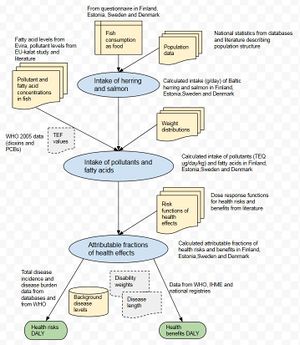

Stakeholders
Who will be affected by the decisions?
- Professional fishers and their organisations
- Anglers and other recreational fishers and their organisations
- Land owner fishers and their organisation (they have inherited rights)
- Saami people also have inherited rights (in Sweden only?)
- Food and fish industry.
- Mink and fox farmers
- All people utilising recreational values of the Baltic Sea (relates to eutrophication)
- Farmers and agricultural sector
- Consumers of fish
- Producers of fish oil and fish meal
- Baltic Sea RAC (Regional Advisory Concil) represents fishers (located in Copenhagen)
- Hydropower plant owners
Who will affect the decisions?
- Food safety organisations (EVIRA, Livsmedelsverket, ...)
- Ministries (of agriculture, environment, and commerce)
- EU: DG Mare, EU Parliament?
- SWAM (Swedish Agency for Marine and Water Management)
Who are interested in the decisions?
- Scientists
- Environmental NGOs
- Bureaucrats
- ICES (International Council for the Exploration of the Sea)
- Helcom
Dependencies
The assessment model is implemented in a modular way in Opasnet. In practice, this means that the data and code used for different parts of the model is located at different pages in Opasnet. In this section, we give the overview and links to the module pages, and all details can be found from there. The whole idea of Opasnet is that different modules can be used in different assessments simultaneously, and that updates in any module are fully reflected in all assessments when they are rerun.
The assessment of consumption of fish was based on a survey conducted by Taloustutkimus Ltd in the four study countries. Around 500 adults were recruited from each country, and consumption of fish, especially that of Baltic salmon and herring, was asked. Also, we asked reasons for eating or not eating fish and factors that would increase or reduce fish consumption. Gender and age (18-45 or 45+) were separated in the model.
Concentrations of dioxins and PCBs in fish were based on EU Fish 2 study conducted by THL in 2009. The results were based on pooled and individual fish samples (98 Baltic herring and 9 salmon samples) and analysed for 17 dioxin and 37 PCB congeners. Toxic equivalent quantities (TEQ) were used by multiplying each congener concentration with its potential to induce dioxin-like effects (toxic equivalency factor, TEF) and summing up. Size-specific concentration distributions were estimated for salmon and herring, and dioxin and PCB TEQs using linear regression and hierarchical Bayesian modelling using R (version 3.4.3 and JAGS package, http://cran.r-project.org/). Herring sizes and dioxin concentrations in different scenarios came from the fish growth model by SLU applied in BONUS GOHERR project; those results are published elsewhere (##REF).
Other concentrations. Concentrations of beneficial nutrients in fish were based on published data and a dataset obtained from the Finnish Food Safety Authority Evira. Mercury concentrations in fish in Finland were based on Kerty database produced by the Finnish Environment Institute.
Exposures to pollutants and nutrients were simply products of consumption amounts and concentrations in the consumed fish. An exception to this were the infant's exposures to dioxin and methylmercury during pregnancy and breast-feeding, as they were derived from the mother's exposure using simple toxicokinetic models.
Exposure-response functions were derived for all relevant pollutants and nutrients. Exposure-response functions of dioxins were derived for several endpoints. Tooth defects were based on an epidemiological study in Finland[2]. Cancer morbidity was based on U.S.EPA dioxin risk assessment[3]. Tolerable daily intake was based on EC Scientific Committee on Food recommendation[4]. Exposure-response functions for omega-3 fatty acids on coronary heart disease and stroke mortalities were from a previous risk assessment[5]. Exposure-response function of methylmercury on child's intelligence quotient was based on a previous risk assessment[6]. Exposure-response function for vitamin D was a step function based on the daily intake recommendations for adults in Finland[7].
Burden of disease was estimated in two alternative ways: if the burden of a particular disease in the target population was known, the attributable fraction of a particular compound exposure was calculated. If it was not known, the excess number of cases due to the exposure was estimated using health impact assessment, and this was multiplied by the years under disease per case and the disability weight of the disease. If the exposure-response function was relative to background risk of the disease, disease risks from Finland were used for all countries. Population data was from Eurostat (http://ec.europa.eu/eurostat). Disability weights and durations of diseases were based on the estimates from the Institute for Health Metrics and Evaluation (https://healtdata.org), adjusted using author judgement when appropriate estimates were not available.
Model parameters
We assume that the background exposure is a uniform distribution between zero and the average Finnish intake for nutrients (according to the Finriski study). The typical nutrient intake from Baltic herring is subtracted from the average to avoid double counting.
| Show details | |||||||||||||||||||||||||||||||||||||||||||||||||||||||||||||||||||||||||||||||||||||||||||||||||||||||||||||||||||||||||||||||||||||||||||||||||||||||||||||||||||||||||||||||||||||||||||||||||||||||||||||||||||||||||||||||||||||||||||||||||||||||||||||||||||||||||||||||||||||||||||||||||||||||||||||||||||||||||||||||||||||||||||||||||||||||||||||||||||||||||||||||||||||||||||||||||||||||||||||||||||||||||||||||||||||||||||||||||||||||||||||||||||||||||||||||||||||||||||||||||||||||||||||||||||||||||||||||||||||||||||||||||||||||||||||||||||||||||||||||||||||||||||||||||||||||||||||||||||||||||||||||||||||||||||||||||||||||||||||||||||||||||||||||||||||||||||||||||||||||||||||||||||||||||||||||||||||||||||||||||||||||||||||||||||||||||||||||||||||||||||||||||||||||||||||||||||||||||||||||||||||||||||||||||||||||||||||||||||||||||||||||||||||||||||||||||||||||||||||||||||||||||||||||||||||||||||||||||||||||||||||||||||||||||||||||||||||||||||||||||||||||||||||||||||||||||||||||||||||||
|---|---|---|---|---|---|---|---|---|---|---|---|---|---|---|---|---|---|---|---|---|---|---|---|---|---|---|---|---|---|---|---|---|---|---|---|---|---|---|---|---|---|---|---|---|---|---|---|---|---|---|---|---|---|---|---|---|---|---|---|---|---|---|---|---|---|---|---|---|---|---|---|---|---|---|---|---|---|---|---|---|---|---|---|---|---|---|---|---|---|---|---|---|---|---|---|---|---|---|---|---|---|---|---|---|---|---|---|---|---|---|---|---|---|---|---|---|---|---|---|---|---|---|---|---|---|---|---|---|---|---|---|---|---|---|---|---|---|---|---|---|---|---|---|---|---|---|---|---|---|---|---|---|---|---|---|---|---|---|---|---|---|---|---|---|---|---|---|---|---|---|---|---|---|---|---|---|---|---|---|---|---|---|---|---|---|---|---|---|---|---|---|---|---|---|---|---|---|---|---|---|---|---|---|---|---|---|---|---|---|---|---|---|---|---|---|---|---|---|---|---|---|---|---|---|---|---|---|---|---|---|---|---|---|---|---|---|---|---|---|---|---|---|---|---|---|---|---|---|---|---|---|---|---|---|---|---|---|---|---|---|---|---|---|---|---|---|---|---|---|---|---|---|---|---|---|---|---|---|---|---|---|---|---|---|---|---|---|---|---|---|---|---|---|---|---|---|---|---|---|---|---|---|---|---|---|---|---|---|---|---|---|---|---|---|---|---|---|---|---|---|---|---|---|---|---|---|---|---|---|---|---|---|---|---|---|---|---|---|---|---|---|---|---|---|---|---|---|---|---|---|---|---|---|---|---|---|---|---|---|---|---|---|---|---|---|---|---|---|---|---|---|---|---|---|---|---|---|---|---|---|---|---|---|---|---|---|---|---|---|---|---|---|---|---|---|---|---|---|---|---|---|---|---|---|---|---|---|---|---|---|---|---|---|---|---|---|---|---|---|---|---|---|---|---|---|---|---|---|---|---|---|---|---|---|---|---|---|---|---|---|---|---|---|---|---|---|---|---|---|---|---|---|---|---|---|---|---|---|---|---|---|---|---|---|---|---|---|---|---|---|---|---|---|---|---|---|---|---|---|---|---|---|---|---|---|---|---|---|---|---|---|---|---|---|---|---|---|---|---|---|---|---|---|---|---|---|---|---|---|---|---|---|---|---|---|---|---|---|---|---|---|---|---|---|---|---|---|---|---|---|---|---|---|---|---|---|---|---|---|---|---|---|---|---|---|---|---|---|---|---|---|---|---|---|---|---|---|---|---|---|---|---|---|---|---|---|---|---|---|---|---|---|---|---|---|---|---|---|---|---|---|---|---|---|---|---|---|---|---|---|---|---|---|---|---|---|---|---|---|---|---|---|---|---|---|---|---|---|---|---|---|---|---|---|---|---|---|---|---|---|---|---|---|---|---|---|---|---|---|---|---|---|---|---|---|---|---|---|---|---|---|---|---|---|---|---|---|---|---|---|---|---|---|---|---|---|---|---|---|---|---|---|---|---|---|---|---|---|---|---|---|---|---|---|---|---|---|---|---|---|---|---|---|---|---|---|---|---|---|---|---|---|---|---|---|---|---|---|---|---|---|---|---|---|---|---|---|---|---|---|---|---|---|---|---|---|---|---|---|---|---|---|---|---|---|---|---|---|---|---|---|---|---|---|---|---|---|---|---|---|---|---|---|---|---|---|---|---|---|---|---|---|---|---|---|---|---|---|---|---|---|---|---|---|---|---|---|---|---|---|---|---|---|---|---|---|---|---|---|---|---|---|---|---|---|---|---|---|---|---|---|---|---|---|---|---|---|---|---|---|---|---|---|---|---|---|---|---|---|---|---|---|---|---|---|---|---|---|---|---|---|---|---|---|---|---|---|---|---|---|---|---|---|---|---|---|---|---|---|---|---|---|---|---|---|---|---|---|---|---|---|---|---|---|---|---|---|---|---|---|---|---|---|---|---|---|---|---|---|---|---|---|---|---|---|---|---|---|---|---|---|---|---|---|---|---|---|---|---|---|---|---|---|---|---|---|---|---|---|---|---|---|---|---|---|---|---|---|---|---|---|---|---|---|---|---|---|---|---|---|---|---|---|---|---|---|---|---|---|---|---|---|---|---|---|---|---|---|---|---|---|---|---|---|---|---|---|---|---|---|---|---|---|---|---|---|---|---|---|---|---|---|---|---|---|---|---|---|---|---|---|---|---|---|---|---|---|---|---|---|---|---|---|---|---|---|---|---|---|---|---|---|---|---|---|---|---|---|---|
Disability weights of IHME[8]. Lower means the lower bound of the size group.
PCDD/F and PCB concentration distributions for each fish species and country are estimated in the following way:
Population data from Eurostat database
| |||||||||||||||||||||||||||||||||||||||||||||||||||||||||||||||||||||||||||||||||||||||||||||||||||||||||||||||||||||||||||||||||||||||||||||||||||||||||||||||||||||||||||||||||||||||||||||||||||||||||||||||||||||||||||||||||||||||||||||||||||||||||||||||||||||||||||||||||||||||||||||||||||||||||||||||||||||||||||||||||||||||||||||||||||||||||||||||||||||||||||||||||||||||||||||||||||||||||||||||||||||||||||||||||||||||||||||||||||||||||||||||||||||||||||||||||||||||||||||||||||||||||||||||||||||||||||||||||||||||||||||||||||||||||||||||||||||||||||||||||||||||||||||||||||||||||||||||||||||||||||||||||||||||||||||||||||||||||||||||||||||||||||||||||||||||||||||||||||||||||||||||||||||||||||||||||||||||||||||||||||||||||||||||||||||||||||||||||||||||||||||||||||||||||||||||||||||||||||||||||||||||||||||||||||||||||||||||||||||||||||||||||||||||||||||||||||||||||||||||||||||||||||||||||||||||||||||||||||||||||||||||||||||||||||||||||||||||||||||||||||||||||||||||||||||||||||||||||||||||
Analyses
Indices
- Country (Denmark, Estonia, Finland, Sweden)
- Year (current [concentration data from 2009 but projected to 2018], future)
- Gender (female, male)
- Age (18-45 years, >45 years)
- Fish species (Baltic herring, Baltic salmon)
- Health end-point (coronary heart disease and stroke mortality, tooth defect caused by dioxins, intelligence quotient change in child of a pregnant or nursing woman, exceedance of tolerable daily intake of dioxin, cancer morbidity, and compliance with vitamin D recommendation)
- Compound (TEQ (PCDD/F and PCB), Vitamin D, Omega3 (includes EPA and DHA), MeHg)
Calculations
This section will have the actual health benefit-risk model (schematically described in the above figure) written with R. The code will utilise all variables listed in the Dependencies section above. Model results are presented as tables and figures, and the most important ones are shown on this page.
- 18.5.2017: Archived exposure model Op7748/exposure by Arja (used separate ovariables for salmon and herring) [5]
- Sketches about modelling determinants of eating (spring 2018) [6]
Updated model with ERF2
Preselected for manuscript
Preselected decisions
Select and run
Test run 21.7.2019 [8]
Initiate model
- Model run 16.7.2019 [9]
- Model run 21.7.2019 with all major updates [10]
- Model run 24.7.2019 [11]
- Model run 27.7.2019 with oempty [12]
Health impact model (Monte Carlo)
http://en.opasnet.org/en-opwiki/index.php?title=Special:RTools&id=lKyk5lVbUvvH7xvk
- Archived model runs since 13.3.2017. archived at 6.4.2018
- Model run (first part) 19.4.2018
- Model run with goherr assessment ovariable 14.6.2018 Compound mixtures (5000 iter)
- Model run 4.8.2018 [13]
- Model run 25.8.2018 without goherr ovariable [14]
- Model run 29.8.2018 with sperm concentration [15]
- Model runs 13.10.2018 with infertility and TWI2018 as endpoints
- Model run 19.11.2018 with mc2d=TRUE Policy (Info.improvements, Recomm.herring, Recomm.salmon) 5000 iter
- Model runs with new country codes, updated tooth defect ERF, child IQ disability weight, sensitivity analysis with Luke scaling. Model runs finalised on 31.3.2019.
- Long timeline 1990-2018 5000 iter
- Select.size Ban large/New products (5000 iter)
- Time 2009+2018, Select.size All sizes (5000 iter)
- Background yes/no, Limit 0 or 3 g/d (5000 iter)
- Background, Cons.policy (Info.improvements, Recommendations) (5000 iter)
- Mixtures (5000 iter)
- Exposure-response functions (100 iterations)
- Cons.policy, Background, Luke scaling (5000 iter)
- Background, Cons.policy (10000 iterations) This is the default model run
Exposure-response functions
Create graph objects
- Archived results between 4.6.2017 - 3.3.2018, archived at 6.4.2018
- Model run 8.4.2018 Model run 11.4.2018 with VOI analysis results updated ERF figure 17 20.4.2018 updated dioxin TWI 1→14 pg/kg/week
- Model run 4.8.2018 without gr [18]
- Model run 29.8.2018 with fertility and suggested EFSA dioxin TWI of 2 pg/kg/wk [19]
- Model run 14.10.2018 with all scenarios rerun with infertility [20]
- Graphs saved 14.10.2018 [21] 16.10. [22]
- Graphs plotted 14.10.2018 [23] 16.10. [24]
- VOI analyses without TWI outcomes 18.11.2018 [25]
Print saved graphs
- Run 13.6.2018 [26]
- Run 29.8.2018 with infertility and EFSA's suggested TWI 2 pg/kg/wk [27] (note: this does NOT contain Fig 30 about consumption vs exposure. That code was not run on Opasnet (but it could be)).
- Run 18.10.2018 with (mostly) new THL colours and fig30 [28]
Initiate goherr assessment ovariable
Plot concentrations and survey
- Requires codes Op_en7748/bayes and indirectly Op_en7748/preprocess.
- Model run 1.3.2017 [29]
Interface for BBN model
Health risk-benefit assessment model (BRA) implemented on this page produces also data for the overall Goherr Bayesian belief network model (BBN). In brief, the models are built in a way that they share the important nodes. The following ovariables are used to produce the data for BBN: bgexposure, amount, expoRaw, conc, lengt, BoD. There are merged and then the following information are selected:
- Information improvements
- Food recommendations herring amount
- Food recommendations salmon amount
- Food recommendations for herring size
- Consumer country
- Consumer gender
- Consumer age group
- Size of an indiv. herring in human diet
- Effect of improved information herring
- Human consumption of herring
- Human consumption of salmon
- Effect of improved information salmon
- Other intake of Omega3
- Omega3 intake total
- Dioxin conc herring
- Dioxin conc salmon
- Human intake of dioxin from herring
- Human intake of dioxin from salmon
- Dioxin intake total
- Net burden of disease
- Omega3 from herring
- Omega3 from salmon
As a result a data.frame with 22 columns is produced. This is used to produce 13 csv files, one for each BBN node.
See also
- Sara M. Pires, Géraldine Boué, Alan Boobis, Hanna Eneroth, Jeljer Hoekstra, Jeanne-Marie Membré, Inez Maria Persson, Morten Poulsen, Juliana Ruzante, Jacobvan Klaverena, Sofie T. Thomsen, Maarten J. Nauta. Risk Benefit Assessment of foods: Key findings from an international workshop. Food Research International, Available online 10 September 2018. doi:10.1016/j.foodres.2018.09.021
- Goherr:5.4 Benefit-risk assessment of previous, current and future fish intake
- Omega-3 content in salmon
- Risk and Benefit Assessment of Herring and Salmonid Fish from the Baltic Sea Area: National Food Agency in Sweden performed a risk assessment about the Baltic herring exemption in 2011 and concluded that "In conclusion, a cessation of the exemption from maximum limits would be more beneficial from a public health point-of view than a continued exemption. In the case of no exemption there would be a decreased exposure of the population to dioxins and dl-PCB without any limitation of the intake of beneficial nutrients." The conclusion was based on two criteria: comparison of TWI and intake in women in childbearing age and in children; and a view that large herring with high dioxin levels can be banned and replaced with small herring with low dioxin levels without any other change.[9]
- Swedish Market Basket 2010: Swedish Food Agency performed a market basket study and concluded that the per capita dioxin+PSB intake was 39 (28-49) pg/d TEQ in 2010. This is about one fourth of the tolerable weekly intake (140 pg/d TEQ in a 70-kg person), and therefore it was concluded that such levels do not markedly increase the risk of health effects[10].
- Riksmaten 2010
- Danskernes kostvaner 2011-2013
- Assmuth Timo and Jalonen Pauliina 2005: Risks and management of dioxin-like compounds in Baltic Sea fish: An integrated assessment. Nordic Council of Ministers, Copenhagen.
 Assmuth Jalonen Dioxin risk assessment 2005 [30]
Assmuth Jalonen Dioxin risk assessment 2005 [30] - EFSA 2012. Update of the monitoring of levels if dioxins and PCBs in food and feed. EFSA Journal 10(7):2832. doi: 10.2903/j.efsa.2012.2832
References
- ↑ Asikainen A, Pihlajamäki M, Ignatius S, Meriläinen P, Haapasaari P, Tuomisto J. Human consumption of Baltic salmon and herring in four Baltic Sea countries: unravelling the embedded reasonings. Manuscript.
- ↑ 2.0 2.1 Satu Alaluusua, Pirjo-Liisa Lukinmaa, Terttu Vartiainen, Maija Partanen, Jorma Torppa, Jouko Tuomisto. (1996) Polychlorinated dibenzo-p-dioxins and dibenzofurans via mother's milk may cause developmental defects in the child's teeth. Environmental Toxicology and Pharmacology Volume 1, Issue 3, 15 May 1996, Pages 193-197. doi:10.1016/1382-6689(96)00007-5
- ↑ U.S.EPA. Guidance for Assessing Chemical Contaminant Data for Use in Fish Advisory. Volume 2: Risk Assessment and Fish Consumption Limits, 3rd Edition. 2000. Table 3-1.
- ↑ EC Scientific Committee on Food. (2001) Opinion of the Scientific Committee on Food on the risk assessment of dioxins and dioxin-like PCBs in food. CS/CNTM/DIOXIN/20 final [1]
- ↑ Cohen, J.T., PhD, Bellinger, D.C, PhD, W.E., MD, Bennett A., and Shaywitz B.A. 2005b. A Quantitative Analysis of Prenatal Intake of n-3 Polyunsaturated Fatty Acids and Cognitive Development. American Journal of Preventive Medicine 2005;29(4):366–374).
- ↑ Cohen JT, Bellinger DC, Shaywitz BA. A quantitative analysis of prenatal methyl mercury exposure and cognitive development. Am J Prev Med. 2005 Nov;29(4):353-65.
- ↑ Finnish Nutrition Recommendations 2014 [2]
- ↑ Institute for Health Metrics and Evaluation. (2019) Disability weights for GBD2017 study. http://ghdx.healthdata.org/record/global-burden-disease-study-2017-gbd-2017-disability-weights. Accessed 27 March 2019.
- ↑ Anders Glynn, Salomon Sand and Wulf Becker. Risk and Benefit Assessment of Herring and Salmonid Fish from the Baltic Sea Area. Report 21/2013. Livsmedelsverket, Sweden.[3]
- ↑ National Food Agency. Market Basket 2010 - chemical analysis, exposure estimation and health-related assessment of nutrients and toxic compounds in Swedish food baskets. Report 7/2012. Livsmedelsverket, Sweden. [4]
Keywords
Terminology
- Normative scenarios
- paths you need to take to reach a defined goal
- Expolorative scenarios
- identify key uncertainties and dependencies to describe coherent paths into the future.
- Governance types
- How things are managed (e.g. top down command or co-management).
- Management action
- Actions to be taken based on decision-maker's decision (i.e. decisions)
See also
- Risk and Benefit Assessment of Herring and Salmonid Fish from the Baltic Sea Area
- Swedish Market Basket 2010
- Riksmaten 2010
- Danskernes kostvaner 2011-2013
- Shared understanding of Goherr policy situation using RDF approach (a detail about Baltic herring) [31]
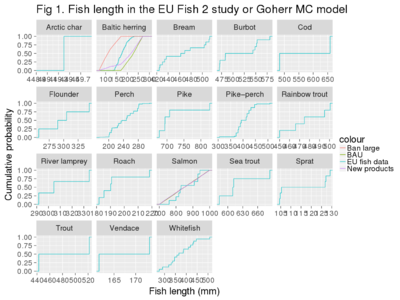
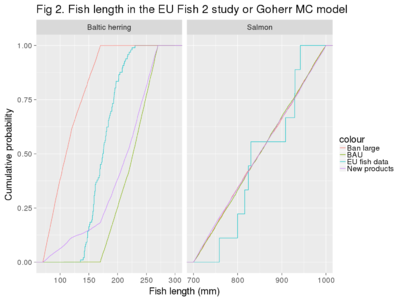
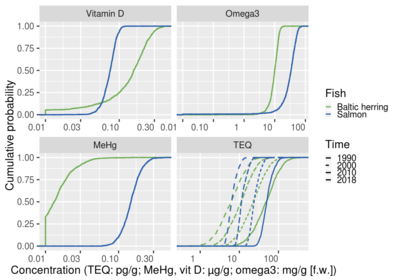
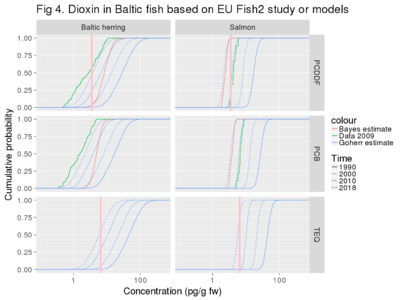
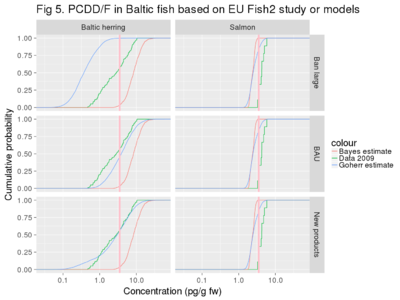


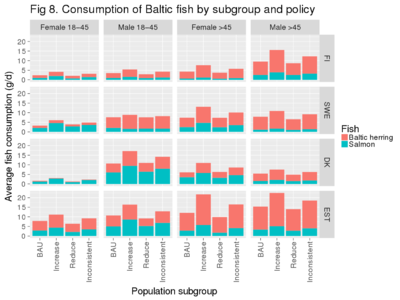
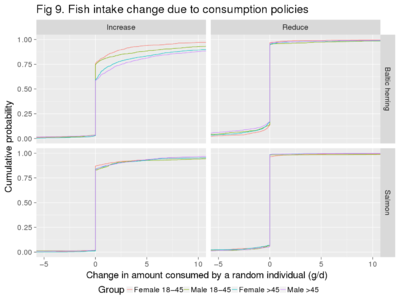
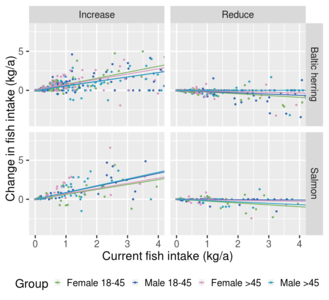
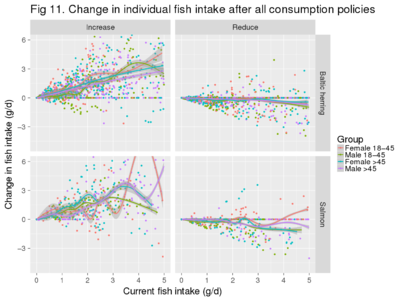
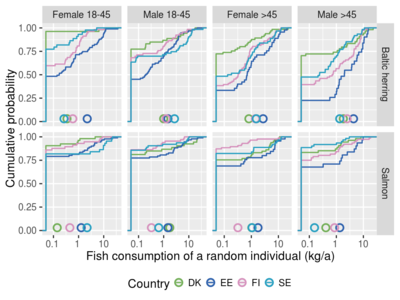
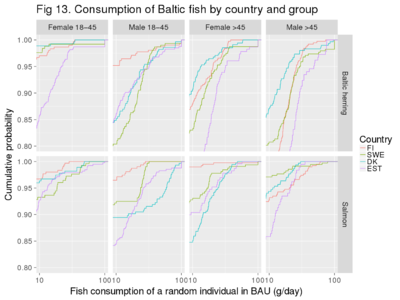
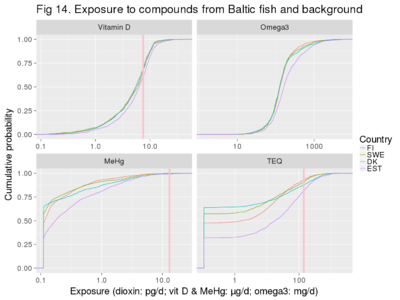

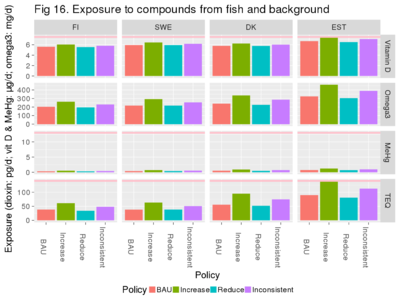
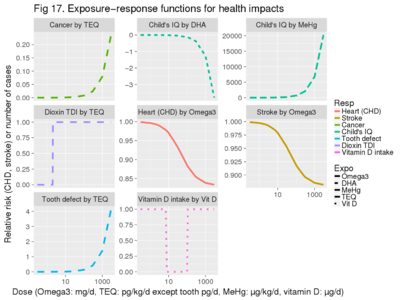
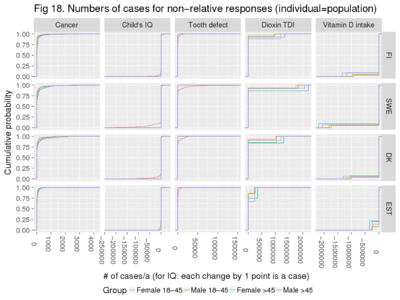
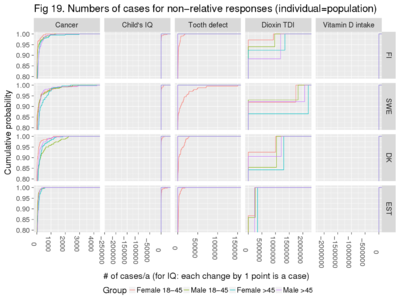
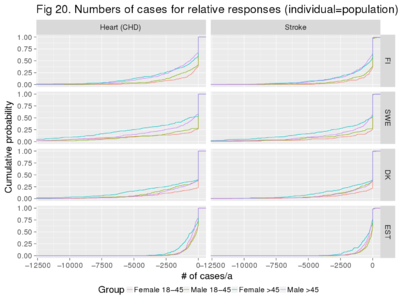
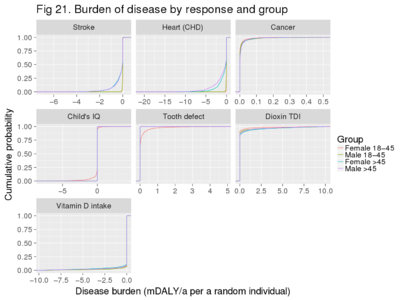
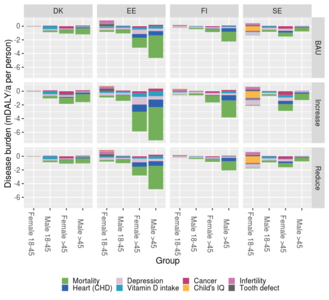
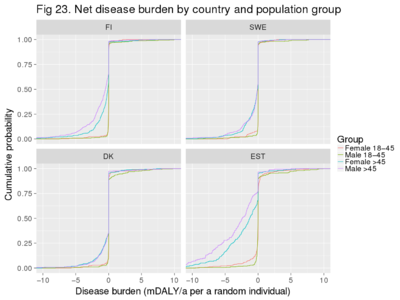
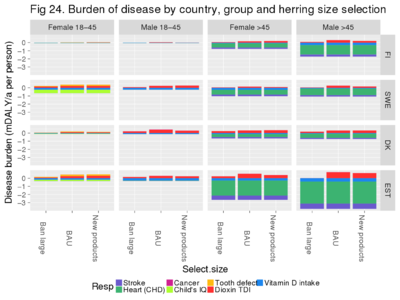
![Time trends show that in each country, the risks have come down a lot and especially the tooth defect risk has reduced. Indeed, these were observed in Finland in children born in the 1980's[2] but not later.](/images/thumb/b/bb/Goherr_benefit-risk_assessment_fig25.svg/400px-Goherr_benefit-risk_assessment_fig25.svg.png)
